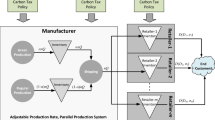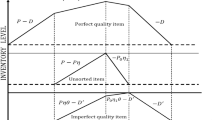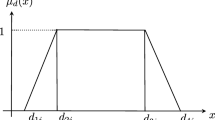Abstract
In the developed countries, most of the customers are aware about the harmful effects of purchased products that pollute the environment. On the other hand, the aim of the manufacturer is to reduce by controlling the pollution rates. Motivating from this situation, a two-plant production model in single manufacturing system with warranty period of the product and carbon emission level dependent demand is developed. The manufacturer inspects every produced item in both plants before sending it to the market. After inspection, a part of imperfect items is reworked to reproduce these items into perfect items and also to reduce the loss of the manufacturer. The objective of the model is to determine the optimal values of the product’s warranty period and the production period in each plant in order to maximize the average profit of the manufacturer subject to some constraints. To illustrate and validate the model, two numerical examples are considered and solved by four meta-heuristic algorithms. Finally, to examine the effects of some significant model parameters on the optimal policy, sensitivity analyses are performed.




















Similar content being viewed by others
References
Alqahtani AY, Gupta SM (2018) Money-back guarantee warranty policy with preventive maintenance strategy for sensor-embedded remanufactured products. J Ind Eng Int 14(4):767–782
Baker JE (1985) Adaptive selection methods for genetic algorithms. In Proceedings of an International Conference on Genetic Algorithms and their applications, Lawrence Erlbaum Associates, Mahwah, New Jersey 101–111
Benjaafar S, Li Y, Daskin M (2010) Carbon Footprint and the management of supply chains: insights from simple models. IEEE Trans Autom Sci Eng 10(1):99–116
Bhunia AK, Shaikh AA, C´ardenas-Barr´on LE (2017) A partially integrated production inventory model with interval valued inventory costs, variable demand and flexible reliability. Appl Soft Comput 55:491–502
Blischke WR, Scheuer EM (1975) Calculation of the cost of warranty policies as a function of estimated life distributions. Naval Res Logist Q 22(4):681–696
Carbontrust (2006) Carbon foot print in supply chain: the next step for business http://teenet.tei.or.th/Knowledge/Paper/carbon foot print in supply chain. PdfS, accessed on 05/10/2009
C´ardenas-Barr´on LE (2009) Economic production quantity with rework process at a single stage manufacturing system with planned backorders. Comput Ind Eng 57(3):1105–1113
Chang WL, Lin J-H (2012) Optimal maintenance policy and length of extended warranty within the life cycle of products. Comput Math Appl 63(1):144–150
Chattopadhyay G, Rahman A (2008) Development of lifetime warranty policies and models for estimating costs. Reliab Eng Syst Saf 93(4):522–529
Chen W, Wu Z, He J, Gao P, Xu S (2007) Carbon emission control strategies for China: a comparative study with partial and general equilibrium versions of the China MARKAL model. Energy 32(1):59–72
Chien Y-H, Sheu S-H (2005) Optimal warranty period and optimal replacement age out-of-warranty. J Chin Inst Ind Eng 22(5):401–407
Chiu YSP (2003) Determining the optimal lotsize for the finite production model with random defective rate, the rework process, and backlogging. Eng Optim 35(4):427–437
Chung KG, C´ardenas-Barr´on LE, Ting PS (2018) The simplified solution procedures for solving replenishment lot size problem with discontinuous issuing policy and rework. J Inf Optim Sci 39(8):1665–1672
Clerc M (1999) The swarm and the queen: towards a deterministic and adaptive particle swarm optimization. Proc IEEE Congr Evolut Comput 3:1951–1957
Clerc M, Kennedy J (2002) The Particle Swarm- explosion, stability and convergence in a multi-dimensional complex space. IEEE Transactions Evolut Comput 6:58–73
Coelho LS (2010) Gaussian quantum-behaved particle swarm optimization approaches for constrained engineering design problems. Expert Syst Appl 37(2):1676–1683
Das S, Manna AK, Mahmoud EE, Abualnaja KM, Abdel-Aty AA, Shaikh AA (2020) Product replacement policy in a production inventory model with replacement period-, stock-, and price-dependent demand. J Math. https://doi.org/10.1155/2020/6697279
Das SC, Manna AK, Rahman MS, Shaikh AA, Bhunia AK (2021) An inventory model for non-instantaneous deteriorating items with preservation technology and multiple credit periods-based trade credit financing via particle swarm optimization. Soft Comput. https://doi.org/10.1007/s00500-020-05535-x
Datta TK (2017) Effect of green technology investment on a production-inventory system with carbon tax. Adv Oper Res 2017:1–12. https://doi.org/10.1155/2017/4834839
Duary A, Rahman MS, Shaikh AA, Niaki STA, Bhunia AK (2020) A new hybrid algorithm to solve bound-constrained nonlinear optimization problems. Neural Comput Appl 32(16):12427–12452
Eberhart R, Kennedy J (1995) A new optimizer using particle swarm theory, In micro machine and human science. Proceedings of the Sixth International Symposium on 1995, 39–43
Ghosh PK, Manna AK, Dey JK, Kar S (2021) Supply chain coordination model for green product with different payment strategies: a game theoretic approach. J Clean Prod 290:125734. https://doi.org/10.1016/j.jclepro.2020.125734
Hammami R, Nouira I, Frein Y (2015) Carbon emissions in a multi-echelon production inventory model with lead time constraints. Int J Prod Econ 164:292–307
Harris I, Naim M, Palmer A, Potter A, Mumford C (2011) Assessing the impact of cost optimization based on infrastructure modelling on CO2 emissions. Int J Prod Econ 131(1):313–321
Harris X, Benjaafar S, Elomri A (2013) The carbon-constrained EOQ. Oper Res Lett 41(2):172–179
Hayek P, Salameh MK (2001) Production lot sizing with the reworking of imperfect quality items produced. Prod Plan Control 12(6):437–584
Holland JH (1975) An efficient genetic algorithm for the travelling salesman problem. Eur J Oper Res 145:606–617
Huang Y-S, Yen C (2009) A study of two-dimensional warranty policies with preventive maintenance. IIE Trans 41(4):299–308
Jain S, TiwariC´ardenas-Barr´on SLE, Shaikh AA, Singh SR (2018) A fuzzy imperfect production and repair inventory model with time dependent demand, production and repair rates under inflationary conditions. RAIRO-Oper Res 52(1):217–239
Manna AK, Dey JK, Mondal SK (2018) Two layers supply chain in an imperfect production inventory model with two storage facilities under reliability consideration. J Ind Prod Eng 35(2):57–73
Manna AK, Dey JK, Mondal SK (2019) Controlling GHG emission from industrial waste perusal of production inventory model with fuzzy pollution parameters. Int J Syst Sci: Oper Logist 6(4):368–393
Manna AK, Dey JK, Mondal SK (2020) Effect of inspection errors on imperfect production inventory model with warranty and price discount dependent demand rate. RAIRO-Oper Res 54(4):1189–1213
Meng F, Su B, Thomson E, Zhou D, Zhou P (2016) Measuring China’s regional energy and carbon emission efficiency with DEA models: a survey. Appl Energy 183:1–21
Modak NM, Panda S, Sana SS (2015) Optimal just-in-time buffer inventory for preventive maintenance with imperfect quality items. Tkhne 13(2):135–144
Michalawicz Z (1996) Genetic Algorithms + Data structure = Evaluation Programs, 3rd revised and extended. Springer, New York
Rahman MS, Manna AK, Shaikh AA, Bhunia AK (2020) An application of interval differential equation on a production inventory model with interval-valued demand via center-radius optimization technique and particle swarm optimization. Int J Intell Syst 35(8):1280–1326
Rahman MS, Duary A, Shaikh AA, Bhunia AK (2020) An application of parametric approach for interval differential equation in inventory model for deteriorating items with selling-price-dependent demand. Neural Comput Appl 32:14069–14085
Rosenblatt MJ, Lee HL (1986) Economic production cycles with imperfect production processes. IIE Trans 18:48–55
Salameh MK, Jaber MY (2000) Economic production quantity model for items with imperfect quality. Int J Prod Econ 64:59–64
Sarkar B (2016) Supply chain coordination with variable backorder, inspections, and discount policy for fixed lifetime products. Mathematical Problems in Engineering. 2016:1–14
Sun J, Feng B, Xu W (2004) Particle swarm optimization with particles having quantum behaviour. In Evolutionary Computation (IEEE Cat. No. 04TH8753) 1:325–331
Sun J, Fang W, Palade V, Wu X, Xu W (2011) Quantum-behaved particle swarm optimization with Gaussian distributed local attractor point. Appl Math Comput 218(7):3763–3775
Sundarakani B, de Souza R, Goh M, Wagner SM, Manikandan S (2010) Modeling carbon footprints across the supply chain. Int J Prod Econ 128(1):43–50
Taleizadeh AA, C´ardenas-Barr´on LE, Mohammadi B (2014) Multi product single machine EPQ model with backordering, scraped products, rework and interruption in manufacturing process. Int J Prod Econ 150:9–27
Tiwari S, Daryanto Y, Wee HM (2018) Sustainable inventory management with deteriorating and imperfect quality items considering carbon emission. J Clean Prod 192:281–292
Wang C-H, Sheu S-H (2001) The effects of the warranty cost on the imperfect EMQ model with general discrete shift distribution. Prod Plan Control 12(6):621–628
Wang Y, Xie T, Yang S (2017) Carbon emission and its decoupling research of transportation in Jiangsu Province. J Clean Prod 142:907–914
World Business Council for Sustainable Development (WBCSD) and World Resources Institute (WRI) (2009) The Greenhouse gas protocol initiative: scope accounting and reporting standard. Review Draft Switzerland, Geneva
Xi M, Sun J, Xu W (2008) An improved quantum-behaved particle swarm optimization algorithm with weighted mean best position. Appl Math Comput 205(2):751–759
Xu W, Sun J (2005) Adaptive parameter selection of quantum-behaved particle swarm optimization on global level. In International Conference on Intelligent Computing, Berlin, Heidelberg 2005, 420-428
Acknowledgment
The authors express their sincere thanks to the editor and the anonymous reviewers for their valuable comments and suggestions which have led to a significant improvement of the manuscript. The first author would like to thank University Grants Commission providing the Dr. D. S. Kothari Post Doctoral Fellowship (DSKPDF) through University of Burdwan for accomplish this research (Vide Research Grant No.F.4-2/2006 (BSR)/MA/18-19/0023). Also the fifth author would like to acknowledge the financial support provided by WBDST\& BT, West Bengal, India for this research (Memo No: 429 (Sanc.)/ST/P/S\& T/16G-23/2018 dated 12/03/2019).
Author information
Authors and Affiliations
Corresponding author
Ethics declarations
Conflict of interest
There is no conflict of interest.
Additional information
Publisher's Note
Springer Nature remains neutral with regard to jurisdictional claims in published maps and institutional affiliations.
Rights and permissions
About this article
Cite this article
Manna, A.K., Benerjee, T., Mondal, S.P. et al. Two-plant production model with customers’ demand dependent on warranty period of the product and carbon emission level of the manufacturer via different meta-heuristic algorithms. Neural Comput & Applic 33, 14263–14281 (2021). https://doi.org/10.1007/s00521-021-06073-9
Received:
Accepted:
Published:
Issue Date:
DOI: https://doi.org/10.1007/s00521-021-06073-9




